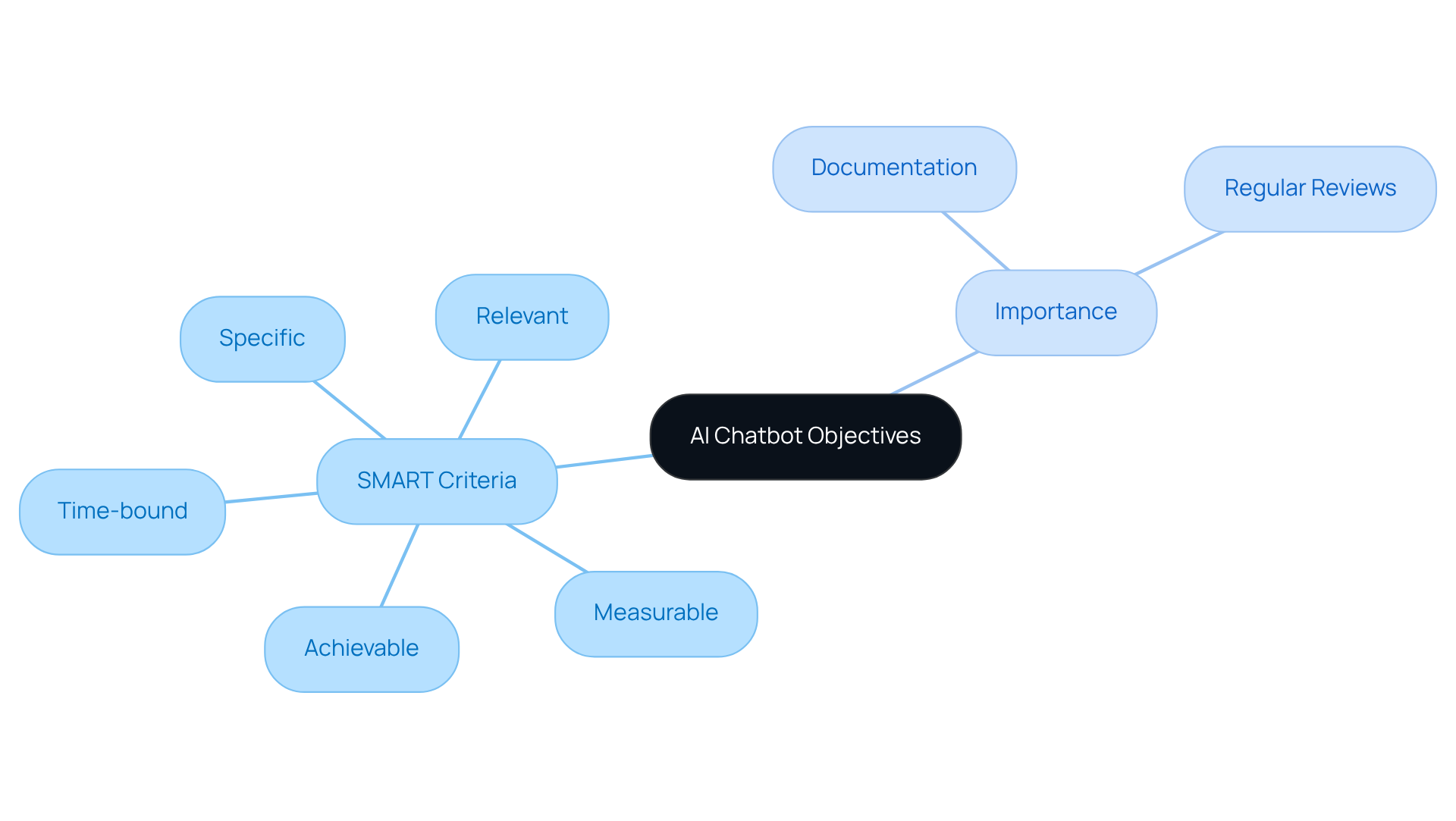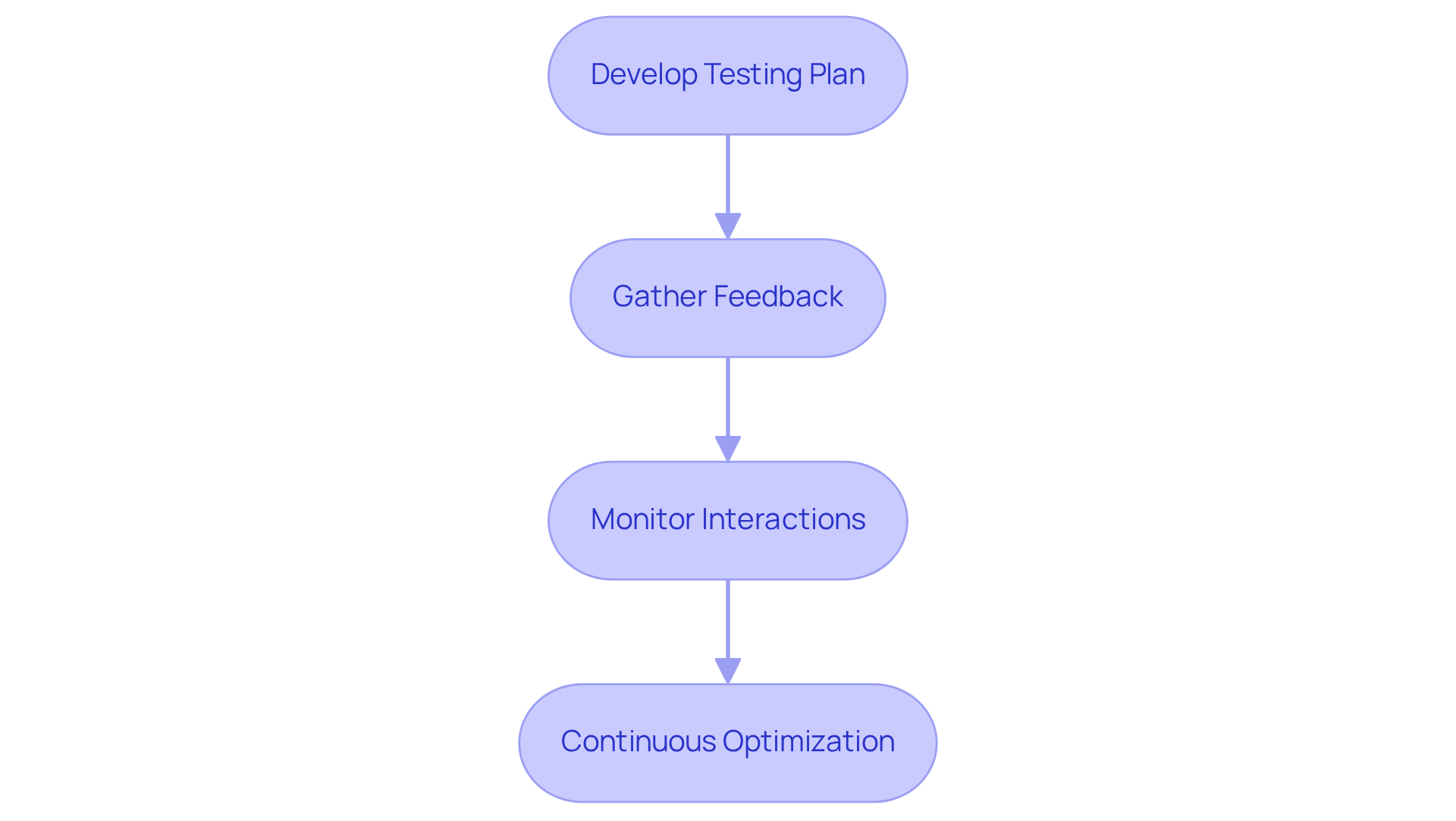
5 Steps to Implement an AI Chatbot for Ecommerce Success
GeneralOverview
This article delineates a five-step process essential for the successful implementation of an AI chatbot in e-commerce. It emphasises the following steps:
- Defining objectives
- Identifying key use cases
- Selecting appropriate technology
- Integrating with existing systems
- Conducting thorough testing before launch
Each step underscores the critical importance of aligning the chatbot’s functionalities with overarching business goals and customer needs. Data illustrates that when these strategies are executed effectively, businesses experience marked improvements in efficiency and customer satisfaction. Embrace this structured approach to harness the full potential of AI solutions in your e-commerce strategy.
Introduction
In an era where customer experience can decisively influence the success of an online business, the implementation of AI chatbots stands out as a transformative force in eCommerce. These digital assistants not only streamline customer interactions but also significantly enhance operational efficiency, presenting businesses with an unparalleled opportunity to boost sales and elevate service quality.
However, the path to effectively integrating an AI chatbot is riddled with challenges. What essential steps must be taken to ensure a seamless implementation that aligns with both customer needs and business objectives?
Define Your AI Chatbot Objectives
Identify specific objectives for your chatbot, such as client support or lead generation. Ensure these objectives adhere to the SMART criteria:
- Specific
- Measurable
- Achievable
- Relevant
- Time-bound
Documenting these objectives is crucial as it guides the development process and aligns efforts with business goals. Furthermore, regularly review and modify these objectives in response to evolving business requirements and client feedback to maintain relevance and effectiveness.

Identify Key Use Cases for Your Chatbot
- Examine client interactions to detect frequent inquiries and issues; remarkably, 90% of client questions can be addressed in 10 messages or fewer. This analysis not only aids in understanding client inquiries but also facilitates the development of a more efficient chatbot. Furthermore, 90% of businesses report faster complaint resolution thanks to digital assistants, underscoring the effectiveness of chatbots in managing inquiries.
- Prioritise use cases based on their potential impact on client experience and operational efficiency. Addressing FAQs, order tracking, and product suggestions can significantly enhance user satisfaction and streamline processes, as 61% of clients prefer self-service options for straightforward issues.
- Develop user personas to capture the diverse needs of your clientele. This strategy allows for personalised interactions, ensuring the chatbot effectively addresses the specific concerns of various segments. Notably, 64% of companies believe that automated assistants enable them to provide a more tailored support experience, ultimately resulting in a 67% increase in sales for organisations utilising automated assistants.
- Validate use cases with stakeholders to ensure alignment with organisational objectives. Engaging team members across departments can yield insights into which functionalities will drive the most value. Significantly, 57% of businesses indicate that employing automated conversation agents leads to substantial ROI with minimal investments needed for implementation, promoting a collaborative approach to their development.
- Implement effective automated conversation applications in client support and sales. For instance, chatbots can automate responses to frequent questions, guide clients through the purchasing process, and assist in upselling, which has been shown to increase revenue by 7-25% in ecommerce environments.
Choose the Right Technology and Features
To effectively navigate the landscape of conversational agent platforms, it is essential to investigate their diverse functionalities, including natural language processing (NLP) and machine learning capabilities. Evaluating key features such as:
- Multi-channel support
- Analytics
- Customization options
is crucial for understanding their potential impact on your operations. Furthermore, considering the integration capabilities of an AI chatbot for ecommerce with existing systems, like CRM and eCommerce platforms, will enhance the overall effectiveness of the solution. Lastly, testing various technologies through demos or trials is vital to assess usability and performance, ensuring that the chosen platform aligns with your organisational goals.
Integrate with Existing Systems and Platforms
Identify the existing systems that the virtual assistant must integrate with, such as inventory management and customer databases.
- Leverage APIs and webhooks to facilitate seamless integration processes.
- Prioritise data security and compliance throughout the integration phase.
- Finally, conduct thorough integration testing to ensure the virtual assistant operates effectively within the established infrastructure.
Test and Optimize Before Launch
To ensure the success of your virtual assistant, develop a comprehensive testing plan that encompasses:
- Functional testing
- Usability testing
- Performance testing
This foundational step is critical in identifying and addressing potential issues before launch. Next, gather feedback from beta users to pinpoint areas for improvement, allowing you to refine the user experience.
Monitoring virtual assistant interactions and analysing performance metrics post-launch is essential; this data will guide your optimization efforts. By continuously optimising the AI chatbot for e-commerce based on user feedback and evolving business needs, you not only enhance its functionality but also align your solution with user expectations, driving greater satisfaction and engagement.

Conclusion
Implementing an AI chatbot in eCommerce presents a significant opportunity to enhance customer engagement and operational efficiency. By clearly defining objectives, identifying key use cases, selecting the right technology, integrating with existing systems, and rigorously testing before launch, businesses can create a powerful digital assistant that meets both customer needs and organisational goals.
Throughout this article, essential steps have been outlined to guide the successful implementation of an AI chatbot. From establishing SMART objectives that drive development to prioritising use cases based on customer interactions, the insights provided illustrate how to create a tailored and effective chatbot experience. Moreover, the importance of technology selection, seamless integration, and continuous optimization cannot be overstated; these elements are crucial for ensuring the chatbot operates effectively and meets evolving business demands.
Ultimately, the adoption of AI chatbots in eCommerce is not merely a trend but a strategic move that can lead to improved customer satisfaction and increased revenue. Businesses are encouraged to embrace this technology, leveraging the outlined steps to create a chatbot that not only addresses customer inquiries but also enhances the overall shopping experience. By doing so, organisations can position themselves for success in an increasingly competitive digital marketplace.
Frequently Asked Questions
What are the key objectives to define for an AI chatbot?
Key objectives for an AI chatbot should include specific goals such as client support or lead generation. These objectives should adhere to the SMART criteria: Specific, Measurable, Achievable, Relevant, and Time-bound.
Why is documenting chatbot objectives important?
Documenting chatbot objectives is crucial as it guides the development process and aligns efforts with business goals. It also allows for regular review and modification in response to evolving business requirements and client feedback.
How can I identify key use cases for my chatbot?
You can identify key use cases by examining client interactions to detect frequent inquiries and issues. Notably, 90% of client questions can be addressed in 10 messages or fewer, which helps in understanding client needs and developing a more efficient chatbot.
What are some common use cases that can enhance client experience?
Common use cases that can enhance client experience include addressing FAQs, order tracking, and providing product suggestions. These functionalities significantly improve user satisfaction, as 61% of clients prefer self-service options for straightforward issues.
How can user personas benefit chatbot development?
Developing user personas helps capture the diverse needs of your clientele, allowing for personalised interactions. This ensures the chatbot effectively addresses the specific concerns of various segments, leading to a more tailored support experience.
What is the impact of automated assistants on sales and support?
Automated assistants can lead to a 67% increase in sales for organisations utilising them. They also enable companies to provide a more tailored support experience, with 64% of companies believing in their effectiveness.
How can I validate chatbot use cases with stakeholders?
Validating use cases with stakeholders involves engaging team members across departments to gather insights on which functionalities will drive the most value. This collaborative approach ensures alignment with organisational objectives.
What are some applications of chatbots in client support and sales?
Chatbots can automate responses to frequent questions, guide clients through the purchasing process, and assist in upselling. This has been shown to increase revenue by 7-25% in ecommerce environments.
Enjoyed this post? Share it with your network!
10 Best AI Sales Tools to Boost Your Team’s Performance

Discover the top 10 best AI sales tools to enhance team performance and drive revenue growth.
Mastering Test Call Numbers: A Step-by-Step Guide for Sales Directors

Elevate your communication with our guide on mastering test call numbers for sales success.
7 Ways Automated Outbound Calls Boost Sales Performance

Discover how automated outbound calls enhance sales performance and streamline communication.
